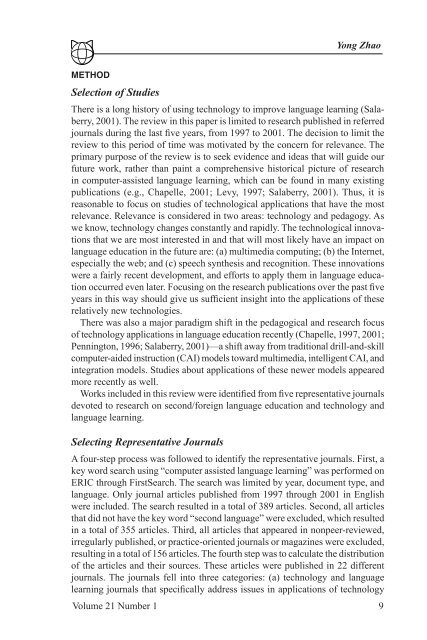Recent Developments in Technology and Language ... - CALICO
Recent Developments in Technology and Language ... - CALICO
Recent Developments in Technology and Language ... - CALICO
You also want an ePaper? Increase the reach of your titles
YUMPU automatically turns print PDFs into web optimized ePapers that Google loves.
METHOD<br />
Selection of Studies<br />
Yong Zhao<br />
There is a long history of us<strong>in</strong>g technology to improve language learn<strong>in</strong>g (Salaberry,<br />
2001). The review <strong>in</strong> this paper is limited to research published <strong>in</strong> referred<br />
journals dur<strong>in</strong>g the last five years, from 1997 to 2001. The decision to limit the<br />
review to this period of time was motivated by the concern for relevance. The<br />
primary purpose of the review is to seek evidence <strong>and</strong> ideas that will guide our<br />
future work, rather than pa<strong>in</strong>t a comprehensive historical picture of research<br />
<strong>in</strong> computer-assisted language learn<strong>in</strong>g, which can be found <strong>in</strong> many exist<strong>in</strong>g<br />
publications (e.g., Chapelle, 2001; Levy, 199 ; Salaberry, 2001). Thus, it is<br />
reasonable to focus on studies of technological applications that have the most<br />
relevance. Relevance is considered <strong>in</strong> two areas: technology <strong>and</strong> pedagogy. As<br />
we know, technology changes constantly <strong>and</strong> rapidly. The technological <strong>in</strong>novations<br />
that we are most <strong>in</strong>terested <strong>in</strong> <strong>and</strong> that will most likely have an impact on<br />
language education <strong>in</strong> the future are: (a) multimedia comput<strong>in</strong>g; (b) the Internet,<br />
especially the web; <strong>and</strong> (c) speech synthesis <strong>and</strong> recognition. These <strong>in</strong>novations<br />
were a fairly recent development, <strong>and</strong> efforts to apply them <strong>in</strong> language education<br />
occurred even later. Focus<strong>in</strong>g on the research publications over the past five<br />
years <strong>in</strong> this way should give us sufficient <strong>in</strong>sight <strong>in</strong>to the applications of these<br />
relatively new technologies.<br />
There was also a major paradigm shift <strong>in</strong> the pedagogical <strong>and</strong> research focus<br />
of technology applications <strong>in</strong> language education recently (Chapelle, 199 , 2001;<br />
Penn<strong>in</strong>gton, 1996; Salaberry, 2001)—a shift away from traditional drill-<strong>and</strong>-skill<br />
computer-aided <strong>in</strong>struction (CAI) models toward multimedia, <strong>in</strong>telligent CAI, <strong>and</strong><br />
<strong>in</strong>tegration models. Studies about applications of these newer models appeared<br />
more recently as well.<br />
Works <strong>in</strong>cluded <strong>in</strong> this review were identified from five representative journals<br />
devoted to research on second/foreign language education <strong>and</strong> technology <strong>and</strong><br />
language learn<strong>in</strong>g.<br />
Select<strong>in</strong>g Representative Journals<br />
A four-step process was followed to identify the representative journals. First, a<br />
key word search us<strong>in</strong>g “computer assisted language learn<strong>in</strong>g” was performed on<br />
ERIC through FirstSearch. The search was limited by year, document type, <strong>and</strong><br />
language. Only journal articles published from 199 through 2001 <strong>in</strong> English<br />
were <strong>in</strong>cluded. The search resulted <strong>in</strong> a total of 3 9 articles. Second, all articles<br />
that did not have the key word “second language” were excluded, which resulted<br />
<strong>in</strong> a total of 355 articles. Third, all articles that appeared <strong>in</strong> nonpeer-reviewed,<br />
irregularly published, or practice-oriented journals or magaz<strong>in</strong>es were excluded,<br />
result<strong>in</strong>g <strong>in</strong> a total of 156 articles. The fourth step was to calculate the distribution<br />
of the articles <strong>and</strong> their sources. These articles were published <strong>in</strong> 22 different<br />
journals. The journals fell <strong>in</strong>to three categories: (a) technology <strong>and</strong> language<br />
learn<strong>in</strong>g journals that specifically address issues <strong>in</strong> applications of technology<br />
Volume 21 Number 1 9
















